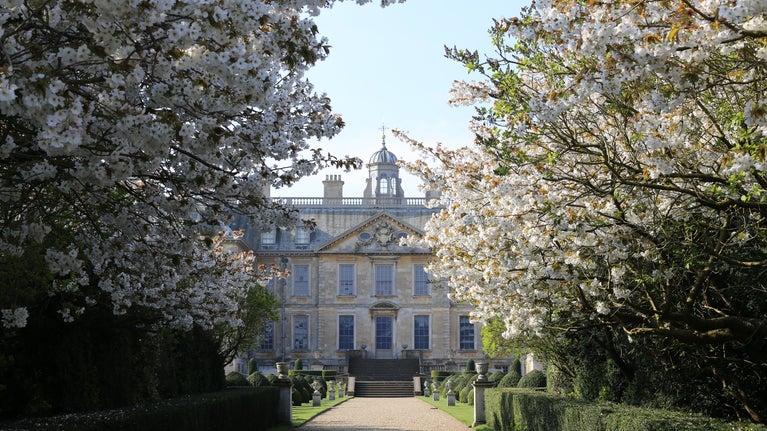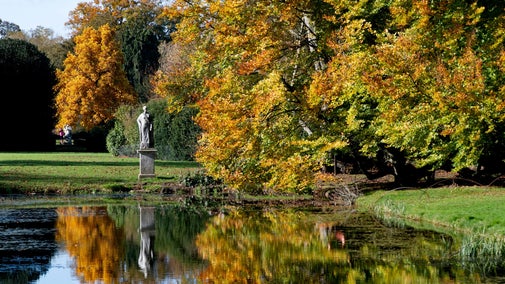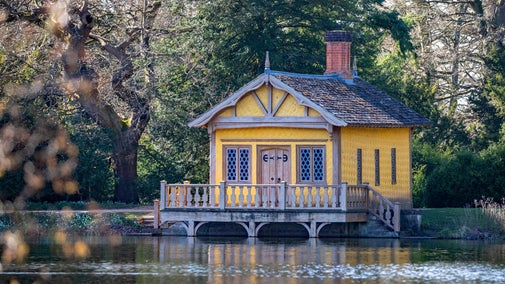
Donate
Everyone needs nature, now more than ever. Donate today and you could help nature flourish and ensure our shared history continues to inspire us all. Thank you for your continued support.
Exploration and relaxation for the whole family
Grantham, Lincolnshire, NG32 2LS

| Asset | Opening time |
|---|---|
| House | 11:00 - 15:30 |
| Adventure playground | 10:00 - 16:00 |
| Garden | 10:00 - 15:00 |
| Park | 10:00 - 16:00 |
| Indoor play | 10:00 - 15:00 |
| Shop | 10:00 - 16:00 |
| Stables Café | 10:00 - 16:00 |
| Second-hand Bookshop | 10:30 - 15:30 |
Please note, Belton may have to close at short notice due to high winds or extreme weather conditions.
| Ticket type | With Gift Aid | Without Gift Aid |
|---|---|---|
| Adult (18+) | £22.00 | £20.00 |
| Child (5-17) under 5s free | £11.00 | £10.00 |
| Family (2 Adults and up to 3 children) | £55.00 | £50.00 |
| 1 adult, 2 children | £33.00 | £30.00 |
| Ticket type | With Gift Aid | Without Gift Aid |
|---|---|---|
| Adult (18+) | £18.70 | £17.00 |
| Child (5-17) under 5s free | £9.40 | £8.50 |
| Family (2 Adults and up to 3 children) | £46.80 | £42.50 |
| 1 adult, 2 children | £28.10 | £25.50 |
The second-hand bookshop is open daily 10.30am - 3.30pm
Cycle parking is located outside the Information and Accessibility Hub.
Dogs on leads are welcome in the gardens, parkland, shops and the Stables Café. Only assistance dogs are allowed in the adventure playground, the indoor adventure play, the mansion, and Conservatory.
Twelve 11kW electric vehicle charging points are available in the car park. Chargers can be accessed using mobile app, RFID card, or contactless payment device. Visit our EV charging provider RAW Charging’s website to download the app in advance of your visit. Available during property opening hours, please bring your own cables.
Electric vehicle charging point - more informationPicnic benches can be found in the gardens and outdoor playground, accessible picnic benches are in the gardens
The Belton Team are available in the Information and Accessibility Hub to support you with your visit. Some uneven surfaces, shuttle service available. Accessible parking, mobility scooter and manual wheelchair hire. Accessible toilets. Stairclimber available in the mansion to upper ground floor, visitors will need to transfer into this facility. Please speak to the Welcome Team or Mansion Team.
Accessible toilets can be found in the parkland toilets, the Stables Café, and the indoor play area
Mansion braille guide available upon request, speak to the Mansion Team
Located in the Information and Accessibility Hub. Please speak to a member of the team.
Designated mobility parking available close to visitor reception
Available in Visitor Reception
Mixture of terrain due to Belton's historic setting. There are smooth and level pathways to key visitor areas, including the indoor play café, stables café, and the shop.
A photograph album of the Mansion is available. Speak to the Welcome or Mansion Team.
Pre-book mobility scooters by calling 01476 566116 and using option 1.
Ramps available in the Italian Gardens and shop to the upper level.
Accessible picnic benches in the gardens.
Stairclimber available to the upper ground floor of the mansion. Visitors will need to be able to transfer into the stairclimber, and then back into a National Trust wheelchair. Manual wheelchairs are offered in the mansion, but unable to accommodate mobility scooters. There are stairs to the upper ground floor and first floor. Speak to the team on arrival.
The ground at Belton, due to its historic setting, can be uneven with cobbles and gravel paths. There are smooth and level pathways to key visitor areas, including the indoor play café, stables café, and the shop
A shuttle service is available around Belton, speak to our Welcome Team on arrival, or any member of staff during your visit
Pre-book wheelchairs by calling 01476 566116 and using option 1.
Located just off the A607, Grantham to Lincoln road. Belton House is signposted from the A1. If travelling from Lincoln, take the second entry into the village. Belton's gates are the first exit on your right.
Cycle parking is in front of the Information and Accessibility Hub.
Follow National Route 15 through Grantham’s parks and along the canal. After you've cycled along Sedgwick Meadows and Wyndham Park, turn right onto Belton Lane, and follow the road until you arrive at Belton's historic entrance at Lion Gates. The South Drive offers a fantastic view of the parkland and the mansion as you journey towards the Information and Accessibility Hub, which can be found on the left past the car park. It takes around 15 mins to cycle from the centre of Grantham to Lion Gates.
Plan your route to Belton using the CycleStreets journey planner via the by bicycle link below. (This journey planner uses OpenStreetMap data which is generally excellent but accuracy cannot be guaranteed. If you come to a footpath or other cycle-prohibited track, please don't ride on it).
Take a look at the events we have coming up this year.

Come and celebrate your best-loved Christmas traditions with us and explore Belton's mansion glittering in festive finery, from 22 November 2025 to 4 Jan 2026.

Read more to discover how you can best access this special place and for full information on accessibility for those with disabilities or additional access needs.

Belton is a three pawprint rated place and offers plenty of opportunities for bounding, jumping and sniffing for dogs. With 1,300 acres to explore, come and join us for a wander with your four-legged friend.

Ignite imaginations with school and group visits to Belton and explore the history, stories, collections and nature of this historic place.

Explore our fun family day out ideas, including our indoor play area and outdoor adventure playground. Make the most of your day out with the kids at Belton.

Our brave little train has hosted thousands of happy passengers over the years. Sadly, one of his engines was recently taken out of action, so we're asking for your help to fundraise for a new more environmentally-friendly and accessible train
Hold your parties, celebrations and functions in the Old School Village Hall at Belton, or discover more about Belton's bookable spaces.

Belton is an exceptional example of Restoration architecture with a world-renowned library and collections of art, silver, and ceramics.
Belton’s formal gardens are of Dutch and Italian design, with cast-iron conservatory and fountain. Pleasure gardens offer relaxing lakeside walks.
Rich in wildlife, Belton Park covers around 1,300 acres with an ancient deer park, grazing sheep, ponds and woodland.
Set within a historic wilderness and arboretum, Belton’s large adventure playground and miniature train rides promise hours of family fun.
The main Stables Café has indoor and outdoor seating. There is also a playground kiosk and seasonal ice cream parlour.
Belton's shop sells a wide range of products including homeware, toys, food, gardening, plants and locally sourced products. There is also a large second-hand bookshop.
The Ride indoor play café is the ideal spot for family fun when you want to avoid wet weather. Kids can play on the slides and climb through entertaining obstacles while adults enjoy a warming drink and snack.
Christmas at Belton returns for 2025 with a brand-new light trail, stunning installations, and all the festive magic you love.

Join us for some fun crafting inspired by the season, from Christmas decorations to gift bags and paper sparklers! All crafts are free with donations welcome to help us replenish stock.

Get outdoors on a wander and explore the park and gardens at Belton or venture to Bellmount and Londonthorpe Woods. We have a variety of guided walks to book onto, so whether you're looking for a wander to soothe the soul or learn more about this area's military history, there's something for everyone. Book your space now.

Come and celebrate your best-loved Christmas traditions with us and explore Belton's mansion glittering in festive finery, from 22 November 2025 to 4 Jan 2026.

Explore our fun family day out ideas, including our indoor play area and outdoor adventure playground. Make the most of your day out with the kids at Belton.

Packed full of treasures, discover a mansion bursting with history. Belton's collection tells a story rich in global history and our work will focus on bringing those stories to life.

Explore 1,300 acres of parkland at Belton and find out more about the wildlife you may see along the way, including the herd of historic fallow deer.

Explore the gardens at Belton, including the Italian Garden, a Conservatory and a Dutch Garden with formal bedding schemes. Whatever time of year you visit, the shifting seasons provide a great variety of colour and wildlife to see.

Explore the Pleasure Grounds at Belton and get closer to nature via woodland paths that meander past unusual trees, water features, and follies.

This circular walk at Belton Park passes key features of ancient woodland and the site of a deserted medieval village.

Rest and refuel in a historic setting or treat yourself to something special to take home. Find out about our dog-friendly café and other places to eat and shop.


A pretty, detached cottage in Belton village, with the whole of the majestic Belton estate on your doorstep waiting to be explored.
Surrounded by nature, Belton Woods Hotel, Spa & Golf Resort is your scenic base to explore the charming Lincolnshire countryside. Strolling through our peaceful, leafy grounds, you’ll have to pinch yourself to believe you’re just an hour’s train ride from London King’s Cross. Receive 10% off your booking when entering the code BELT10B.

Christmas at Belton promises to be even more magical this year, with a new after-dark illuminated trail transforming the gardens into a twinkling winter wonderland.
Add a little sparkle to your visit this festive season and wander through spectacular rooms decorated with twinkling lights and showstopping trees.
Bring your little ones (under 5s) to our Belton Acorns sessions! Enjoy learning about the beauty of Belton by engaging in crafts, play, song, and outdoor fun.
Explore the Textures and Treasures Christmas display in the mansion with a British Sign Language Interpreter.
Whether you're just curious as to why we have a cliff running through the estate, or have an interest in earth sciences, this walk offers a fresh perspective on the landscape.
In collaboration with Belton Acorns, join our walking group created for anyone with pushchair-aged children. During these accessible and beautiful walks, you can meet other adults, find support and build up your fitness on a basic level.
Join one of our garden volunteers for an introduction to the formal gardens and hear about the history of the Italian and Dutch Gardens.
Generations of the Brownlow family made their mark on Belton, commissioning the finest designers and craftsmen of their age to shape Belton Estate. The house and gardens showcase cutting edge design and innovation, from 17th century sash windows to a cast iron-framed conservatory in the Italian Garden, made possible thanks to the Industrial Revolution.
Belton House contains impressive art, silver, and porcelain collections, as well as a world-renowned library. Outside there is a deer park, pleasure grounds, and formal gardens of Dutch and Italian design.
Today, Belton welcomes new generations to explore the ancient deer park, picnic in the pleasure grounds, or burn off energy in the National Trust's largest outdoor adventure playground.
The Belton Estate played a significant supporting role in the First World War. Find out about the small town, with hospital and cinema, built for 20,000 men of Kitchener’s Army.

Learn about the history and work of the creative women who represent the spirit of Belton, and view their impressive work on your visit to Belton House.

Whether you're looking to help in the great outdoors, connect with the public or get up close and personal with Belton, there's lots of opportunities here. Or if you’re looking for a team building day and wish to support a charity at the same time, Belton is a great place to choose.

Take a closer look at 400 years of ambitious collecting, where treasures include English portraiture, Oriental ceramics and a restored lapis lazuli cabinet.

Richmond Barthé was an African American figurative artist practising from the 1930s to the 1980s. A rare oil on canvas portrait in the collection at Belton House, Lincolnshire, has recently been attributed to Barthé. The portrait offers new insight into a lesser-known aspect of his work and has served as a catalyst for exploring his story.

In partnership with the Woodland Trust, we have exciting plans for Londonthorpe Woods and the eastern side of the Belton Estate.
Work at Belton uncovers stories from the past and preserves over 400 years of history, helping us to look after this special place for everyone, for ever.

This project uncovered many secrets held by Belton’s Grade I listed Stables and restored this special piece of history for everyone to enjoy.

Everyone needs nature, now more than ever. Donate today and you could help nature flourish and ensure our shared history continues to inspire us all. Thank you for your continued support.
By sharing your email address you’re agreeing to receive marketing emails from the National Trust and confirm you’re 18 years old or over. Please see our for more information on how we look after your personal data.